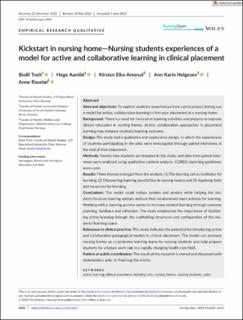| dc.contributor.author | Tveit, Bodil | |
| dc.contributor.author | Aamlid, Hege | |
| dc.contributor.author | Amsrud, Kirsten Eika | |
| dc.contributor.author | Helgesen, Ann Karin | |
| dc.contributor.author | Raustøl, Anne | |
| dc.date.accessioned | 2023-10-24T07:04:31Z | |
| dc.date.available | 2023-10-24T07:04:31Z | |
| dc.date.created | 2023-06-19T13:35:05Z | |
| dc.date.issued | 2023 | |
| dc.identifier.citation | Nursing Open. 2023, 10, 6602–6613. | en_US |
| dc.identifier.issn | 2054-1058 | |
| dc.identifier.uri | https://hdl.handle.net/11250/3098222 | |
| dc.description.abstract | Aims and objectives
To explore students' experiences from a pilot project testing out a model for active, collaborative learning in first-year placement at a nursing home.
Background
There is a need for innovative learning activities and projects to improve clinical education in nursing homes. Active, collaborative approaches in placement learning may enhance students learning outcome.
Design
The study had a qualitative and explorative design, in which the experiences of students participating in the pilot were investigated through paired interviews at the end of their placement.
Methods
Twenty-two students participated in the study, and data from paired interviews were analysed using qualitative content analysis. COREQ reporting guidelines were used.
Results
Three themes emerged from the analysis: (1) The learning cell as facilitator for learning; (2) Discovering learning possibilities in nursing homes and (3) Applying tools and resources for learning.
Conclusions
The model could reduce tension and anxiety while helping the students focus on learning options and use their environment more actively for learning. Working with a learning partner seems to increase student learning through common planning, feedback and reflection. The study emphasises the importance of facilitating active learning through the scaffolding structures and configuration of the students' learning space.
Relevance to clinical practice
This study indicates the potential for introducing active and collaborative pedagogical models in clinical placement. The model can promote nursing homes as a conducive learning arena for nursing students and help prepare students for a future work role in a rapidly changing health care field.
Patient or public contribution
The result of the research is shared and discussed with stakeholders prior to finalising the article. | en_US |
| dc.language.iso | eng | en_US |
| dc.publisher | Wiley | en_US |
| dc.rights | Attribution-NonCommercial-NoDerivatives 4.0 Internasjonal | * |
| dc.rights.uri | http://creativecommons.org/licenses/by-nc-nd/4.0/deed.no | * |
| dc.subject | active learning | en_US |
| dc.subject | clinical placement | en_US |
| dc.subject | nursing homes | en_US |
| dc.subject | nursing students | en_US |
| dc.subject | pairs | en_US |
| dc.title | Kickstart in nursing home-Nursing students experiences of a model for active and collaborative learning in clinical placement | en_US |
| dc.type | Peer reviewed | en_US |
| dc.type | Journal article | en_US |
| dc.description.version | publishedVersion | en_US |
| dc.rights.holder | © 2023 The Authors. | en_US |
| dc.subject.nsi | VDP::Medisinske Fag: 700::Helsefag: 800::Sykepleievitenskap: 808 | en_US |
| dc.subject.nsi | learning cells | en_US |
| dc.source.pagenumber | 6602–6613 | en_US |
| dc.source.volume | 10 | en_US |
| dc.source.journal | Nursing Open | en_US |
| dc.identifier.doi | 10.1002/nop2.1920 | |
| dc.identifier.cristin | 2155865 | |
| cristin.ispublished | true | |
| cristin.fulltext | original | |
| cristin.qualitycode | 1 | |

